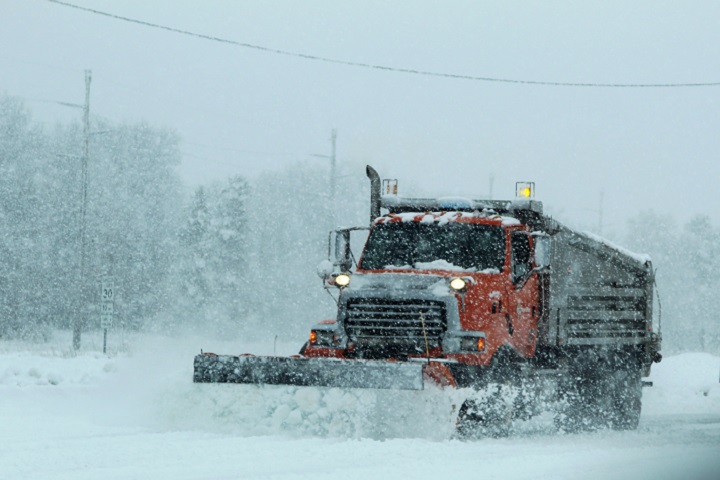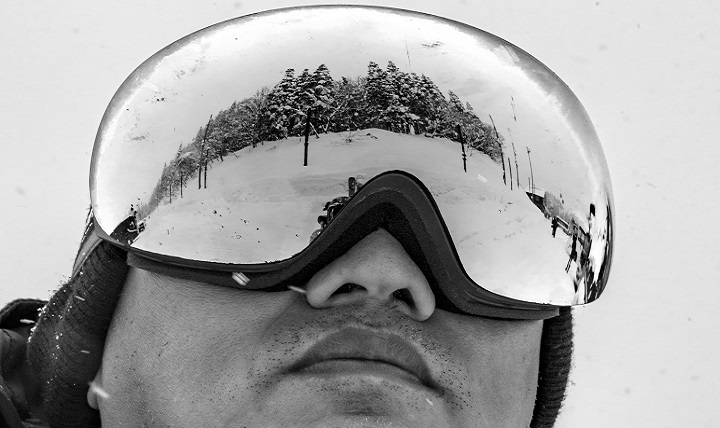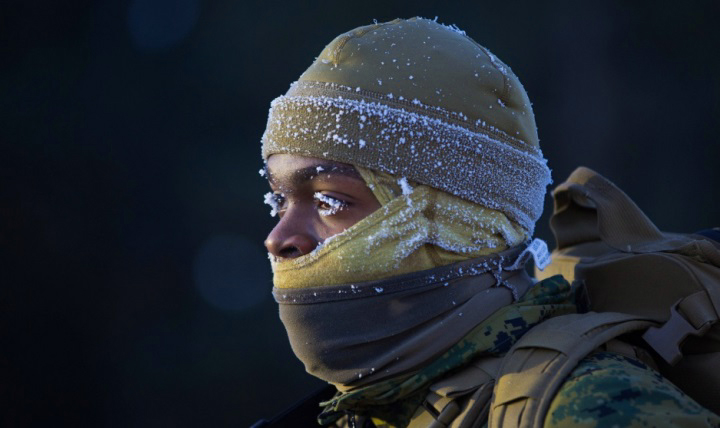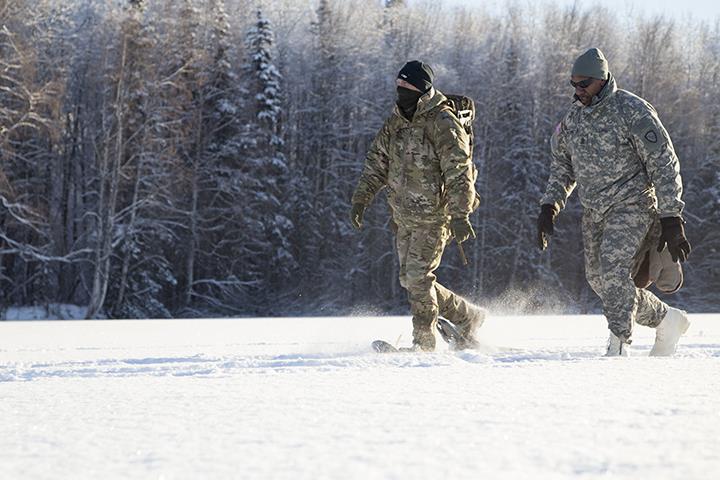
Winter safety tips to stay safe, healthy

A heavy-equipment operator with Fort McCoy snow removal, drives a plow truck to move snow. Winter can be a hazardous time of year. Frigid temperatures and slick roads can be dangerous. (U.S. Army photo by Scott T. Sturkol)
Winter can be a hazardous time of year. Frigid temperatures and slick roads can be dangerous. Being prepared and knowing your TRICARE health care options will help you and your family remain safe this winter. The Centers for Disease Control and Prevention (CDC) provide a number of winter safety tips to help you prepare for freezing temperatures, and prevent injuries and illness. When it comes to preparing your home, car, and family during the winter months, follow these tips.
Prepare with TRICARE
It’s a good idea to have a health emergency kit with all your TRICARE essentials. If you have chronic conditions, your kit should include a full list of your prescription and over-the-counter medications with dosing instructions. Don’t forget to include contact information for TRICARE, your primary care provider, and an extra supply of drugs and supplies.
If you need medical care after a weather-related illness or injury, TRICARE covers urgent and emergency care. But be sure to follow the rules for your plan for getting care. If you’re not sure of the type of care you need, the Military Health System Nurse Advice Line is available 24/7 to provide health advice.
Prepare your home
Winterize your home to help protect yourself and your family from any potential damage the cold temperatures and snow may bring. Follow these tips to keep your home safe and warm:
- Check your heating systems.
- Clean out chimneys and fireplaces.
- Closely monitor any burning fires or candles.
- Check your carbon monoxide and smoke detectors.
- Remove ice and snow from walkways to prevent slips and falls.
- Keep an emergency kit in your home that includes flashlights, extra batteries, a first-aid kit, extra medicine, and baby items.
- If you lose power, your kit should also include food and water for three days for each family member, warm clothing if you have to evacuate, and toys and games for children.
Prepare your car
Is your car ready for winter travel? It’s not too late to winterize your car. Check out these car care tips to prepare you for winter driving:
- Check your tires and replace with all-weather or snow tires, if necessary.
- Keep your gas tank full to prevent ice from getting in the tank and fuel lines.
- Use a wintertime fluid in your windshield washer.
- Make an emergency kit to keep in your car. Include water, snacks, first-aid kit, blankets, flashlight, extra batteries, portable cell phone charger, and emergency flares.
Prepare your family for outdoor winter activities
Remaining indoors during the winter is appealing. But you and your family may want to venture outdoors to enjoy winter activities. When you do, take these steps to prevent serious injuries and illnesses, like hypothermia and frostbite:
- Wear layers of light and warm clothing, a wind-resistant coat, waterproof shoes, and a hat, gloves, and scarf.
- Work slowly when engaged in outdoor tasks, such as shoveling your driveway or removing snow from your car.
- Take a friend and carry a charged cell phone when participating in outdoor activities.
For more winter weather safety tips, visit the CDC website and TRICARE winter safety kit. Also, check out the disaster preparation information on the TRICARE website, where you can sign up for disaster alerts.
2019 TRICARE Winter Safety Kit
Infographic
1/22/2019

This infographic provides tips and information about staying safe and warm during a snow storm.
The relentless winter poses risk for head injuries
Article
3/21/2018

Whether snowboarding or walking on an icy sidewalk, winter conditions and sports can pose an increased risk for traumatic brain injuries
No chill zone: Give winter weather injuries the cold shoulder
Article
2/5/2018

Learn preventive steps to reduce risks of cold-temperature injuries
2018 #ColdReadiness Twitter chat recap: Preventing cold weather injuries for service members and their families
Fact Sheet
2/5/2018
To help protect U.S. armed forces, the Armed Forces Health Surveillance Branch (AFHSB) hosted a live #ColdReadiness Twitter chat on Wednesday, January 24th, 12-1:30 pm EST to discuss what service members and their families need to know about winter safety and preventing cold weather injuries as the temperatures drop. This fact sheet documents ...
Incidence rates of cold weather injuries: Non-Hispanic black service members, five cold weather seasons, July 2012 – June 2017
Infographic
1/18/2018

This infographic documents incidence rates of cold weather injuries among non-Hispanic black service members during the July 2012 – June 2017 cold weather seasons.
2016 – 2017 Cold Season, Cold Weather Injuries, Active and Reserve Components, U.S. Armed Forces
Infographic
1/18/2018

This infographic documents cold weather injuries among the active and reserve components of the U.S. Armed Forces for the 2016 – 2017 cold season.
Five cold seasons: July 2012-June 2017, Active reserve component service members who were diagnosed with a cold weather injury
Infographic
1/18/2018

This infographic provides information on active and reserve component service members who were affected by any cold weather injury during the July 2012 – June 2017 cold seasons.
Update: Cold Weather Injuries, Active and reserve components, U.S. Armed Forces, July 2012 – June 2017
Infographic
1/18/2018

This infographic provides an update for cold weather injuries among active and reserve components, U.S. Armed Forces, July 2012 – June 2017.
Percentages of each Service’s cold weather injuries, 2016 – 2017 cold season
Infographic
1/18/2018

This infographic documents the percentages of each service’s cold weather injuries, U.S. Armed Forces for the 2016 – 2017 cold season.
Cold weather injuries by military location, U.S. Armed Forces, July 2012 – June 2017
Infographic
1/18/2018

This infographic documents cold weather injuries by military location among U.S. Armed Forces for the July 2012 – June 2017 cold seasons.
Five cold seasons: July 2012 – June 2017, Cold injuries during deployments
Infographic
11/3/2017

This infographic documents cold injuries during deployments outside of the United States for the July 2012 – June 2017 cold seasons (five-year surveillance period).
Winter sports safety: Got a helmet?
Article
2/2/2017

Most people don’t associate winter sports with concussions the way football, soccer and lacrosse are
Cold injuries among active duty U.S. service members drop to lowest level since winter 2011–2012
Article
1/23/2017

Cold injuries among active duty U.S. service members drop to the lowest level since winter 2011-2012, according to a study published in Defense Health Agency’s Armed Forces Health Surveillance Branch (AFHSB) peer-reviewed journal, the Medical Surveillance Monthly Report.
Facts on Cold Injuries
Infographic
1/9/2017

This infographic provides information on the overall incidence rates of cold injuries among U.S. service members during a July 2011-2016 five-year surveillance period.
Human Physiologic Responses to Cold Exposure
Infographic
1/9/2017

Human Physiologic responses to cold exposure preserve core body temperature, but those responses may not be sufficient to prevent hypothermia if heat loss is prolonged. This infographic offers helpful information on preserving core body temperature to counter the threat from cold environments.






















.png)











No hay comentarios:
Publicar un comentario